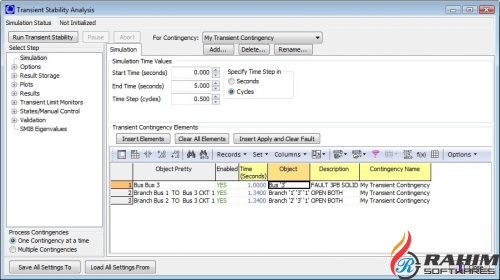

Interface is neat and intuitive but the performance of the interface could be affected by internet connectivity speeds which is a drawback of online software. Interactive high resolution solar resource maps (iMaps) allow users to accurately pinpoint site location. Simulation based easy setup in three steps. Allows companies to use their API and access SolarGis through 3rd party apps. It is only available as an online version, so an internet connection is mandatory. It automatically calculates terrain shading however there are no options for setting up surrounding structures or do near shading analysis.
IN POWER WORLD SIMULATOR PROBLEM 2.32 SOFTWARE
It is a cloud based software that works on the SaaS (software as a service) platform and claims their data is highly accurate and offers a rigorous systematic validation approach increasing data reliability.Īccurate satellite data allows user to make estimation of solar radiation and PV power potential of a location and generate report in 14 languages. This software comes from solar resource database provider SolarGis.

(Fig.2b) Monthly Generation, Economic Calculations and Efficiency Report PVPLANNER No scope for module or inverter data to be added to calculation. There is no option to import weather data from common sources like TMY3. Very limited automation and no wizards available.ģ00 locations are bundled with the software. It is a collection of macro enabled spreadsheets. Very basic and handy for calculation when data is entered manually for every parameter. Simple graph or tabulated data can be generated but cannot be exported. Not suitable for calculation of PV power in real world conditions. All data to be added manually and therefore it is difficult to quickly compare generation data by switching module data, site capacity or location. Simple program that calculates PV energy output based on a generic module and inverter. This program is targeted for academic purposes. Fully loaded permanent version available in Commercial USD 4,200/INR 280,000 Educational USD 2,100/INR 140,000 and Student USD 350 annually/ INR 23,407 annuallyĭeveloped by faculties of University of Wisconsin, PV F-Chart is a PV system analysis design program that uses solar radiation data to calculate PV power generation not taking into account variations caused by PV modules, inverters and other variables. Only 8 modules (including 1 generic) and 8 (including 1 generic) inverters are included in the program.Ĭloud licensing available.
IN POWER WORLD SIMULATOR PROBLEM 2.32 FREE
Does not come bundled with free weather data.Ĭan import module data. Also NASA and SolarGIS data can be imported from their websites. Not intuitive and too many parameters to be added manually.Ĭan import TMY2/TMY3 data from NREL website. Schematic View is useful. Graphical menu system is a plus. Many loss factors during PV power generation are not added to calculation. Also PV electricity generation report is less comprehensive and detailed due to limited information on weather data and module data. Does not generate IV curve data or do shading analysis. Factors like wind speed, fuel cost and emissions penalties can be included in the calculation. HOMER stands for Hybrid Optimization Model for Multiple Energy Resources and comes with Simulation, Optimization and Sensitivity Analysis tools.ĬAPEX and OPEX calculation possible using a project wizard. The following criteria have been considered:ĭeveloped by NREL (National Renewable Energy Laboratory) USA and later enhanced and distributed by Homer Energy is a micro-grid optimization software. Based on the author's individual attempt at using these programs under constant project parameters ratings have been provide at the end of the article. The analysis has been done with focus on SPV power only and hence programs that simulate other sources of renewable energy like wind, biomass, etc. may not necessarily get more preference. System Advisor Model (SAM) - National Renewable Energy Laboratory (NREL), USAĬomparisons of these programs have been made to ascertain how good each are in design and simulation of solar PV power systems. RETscreen – Natural Resources Canada, Canada The programs listed are as follows (in alphabetical order): Main features and prices included.Ī recent publication by the Ministry of New and Renewable Energy (MNRE) and The Energy and Resources Institute (TERI) listed 7 PV simulation software that are commonly used to design Solar PV systems worldwide. A detailed study of 7 unique solar PV design and simulation software(s) that were listed in a 2015 publication by MNRE/TERI.


 0 kommentar(er)
0 kommentar(er)
